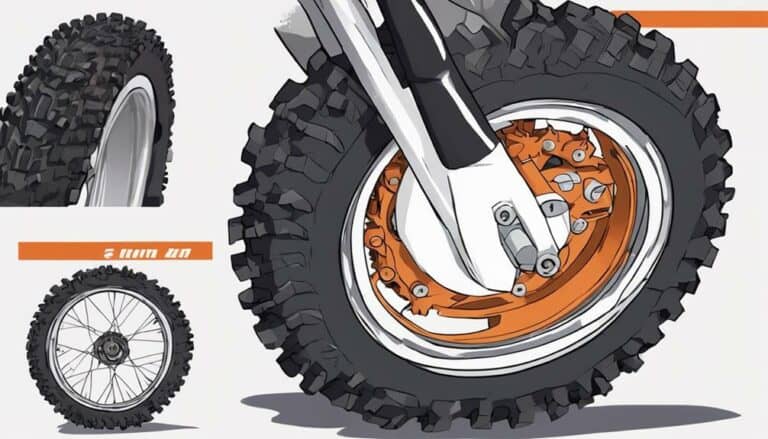You may not realize that the numbers on dirt bike tires hold important information about their size and compatibility with your bike. Understanding these numbers can have a big impact on your riding experience and performance on different terrains.
By deciphering these codes, you can make sure that you equip your dirt bike with the right tires to optimize traction, handling, and overall safety.
So, next time you're eyeing those numbers on your dirt bike tires, know that they hold the key to unleashing your bike's full potential.
Key Takeaways
- Tire size numbers indicate width, aspect ratio, and rim diameter for proper bike performance.
- DOT stamp numbers reveal manufacturer details, tire size, and production week/year for legality and safety.
- Alphanumeric tire codes decode width, aspect ratio, and rim diameter ensuring compatibility.
- Speed ratings on dirt bike tires, represented by letters, correspond to specific speed ranges for optimal stability.
Understanding Dirt Bike Tire Sizes
When selecting dirt bike tires, understanding the numerical information on the sidewall is essential for optimizing performance and handling on varying terrains. The tire size, indicated in millimeters, consists of three key measurements: width, aspect ratio, and rim diameter.
The width, denoted by the first number, represents the widest distance between the sidewalls in millimeters. The aspect ratio, the second number, reveals the sidewall height as a percentage of the tire's width. Finally, the rim diameter shows the size of the wheel the tire is intended to fit.
By choosing the correct tire size, you directly impact engine acceleration, traction, and overall performance on your dirt bike. It's important to adhere to manufacturer recommendations and consult your owner's manual as they provide suggested tire sizes based on factors like weight, power output, and the type of terrain you'll be riding on.
Properly matching the tire size to your bike's specifications can significantly enhance your riding experience.
Decoding DOT Stamp Numbers
To decipher the DOT stamp numbers on dirt bike tires, analyze the alphanumeric code starting with 'DOT' and containing manufacturer, tire plant, size, and production date details. Here are some key points to analyze when decoding the DOT stamp:
- The DOT code consists of 10-12 alphanumeric characters.
- The manufacturer and tire plant information is embedded in the DOT stamp.
- The tire size is part of the code and helps identify compatibility.
- The last four digits of the code indicate the week and year of production.
- Understanding the DOT stamp is essential for ensuring tire legality, safety, and compliance with regulations.
Interpreting Tire Size Numbers
Understanding the numerical markings on dirt bike tires is essential for selecting the appropriate size that fits your bike correctly and optimizes performance. These numbers on dirt bike tires represent important measurements.
The first number indicates the tire width, measured in millimeters, showing the widest point between the sidewalls. The second number reveals the aspect ratio, representing the sidewall height as a percentage of the tire's width. Finally, the third number signifies the rim diameter or wheel size where the tire will fit.
When choosing a tire size for your dirt bike, consider these numbers carefully. For instance, a tire marked as 120/80-19 means the tire is 120 mm wide, with a sidewall height that's 80% of the width, and it fits a 19-inch rim.
Understanding these numerical indicators is important for selecting the right tire size that meets your dirt bike's requirements and guarantees top performance on various terrains.
Unraveling Alphanumeric Tire Codes
Translating alphanumeric tire codes found on dirt bike tires provides a standardized representation of width, aspect ratio, and rim diameter for easy interpretation and selection. Understanding these codes is essential for choosing the right tires for your bike. Here are some key points to help you decipher alphanumeric tire codes effectively:
- The first number in the code indicates the tire width in millimeters.
- The second number represents the aspect ratio, showing the sidewall height as a percentage of the tire's width.
- The third number signifies the rim diameter or wheel circumference.
Alphanumeric tire codes help standardize tire size information for clearer understanding. By decoding these codes, you can quickly identify the dimensions of the tire and guarantee compatibility with your dirt bike.
Mastering these alphanumeric codes will empower you to make informed decisions when selecting tires for your off-road adventures.
Explaining Speed Ratings on Tires
Speed ratings on dirt bike tires, indicated by letters like J, K, L, M, N, P, Q, R, S, T, U, H, V, W, Y, and Z, define the maximum speeds the tires can handle. Each letter corresponds to a specific speed range, with higher letters representing higher speeds.
When selecting tires, understanding these speed ratings is important to make sure they match the intended riding conditions. Tires with higher speed ratings offer increased stability during high-speed riding, enhancing safety and overall performance.
Checking the speed rating of dirt bike tires is essential to guarantee the best handling and durability while riding at varying speeds. By aligning the tire's speed rating with your riding habits, you can enjoy a safer and more controlled experience on different terrains.
Conclusion
To summarize, deciphering the numbers on dirt bike tires is vital for optimizing performance. By understanding the width, aspect ratio, and rim diameter, riders can select the right size for their specific needs.
Remember to consult the owner's manual and tire manufacturer for recommended sizes based on factors like weight and power delivery. When it comes to dirt bike tires, numbers aren't just numbers – they're essential indicators of performance capability.

